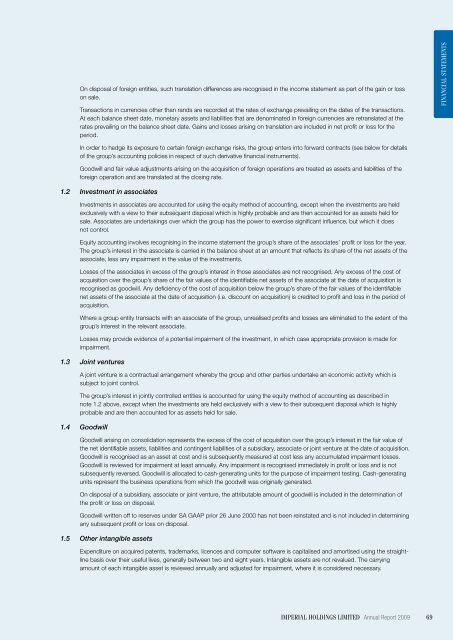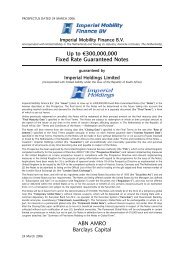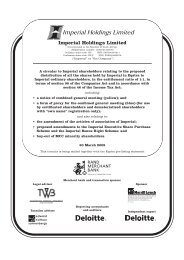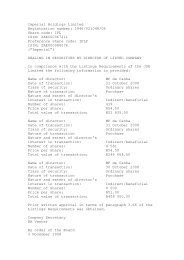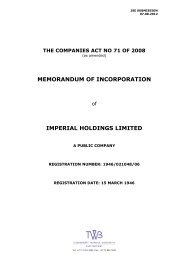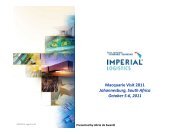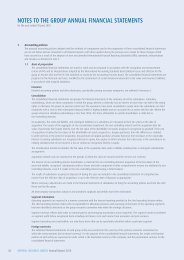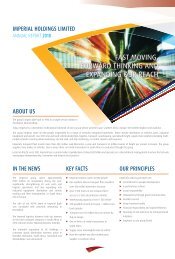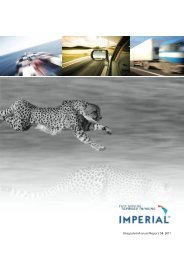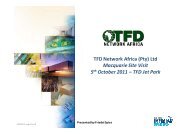4.0 - Imperial
4.0 - Imperial
4.0 - Imperial
You also want an ePaper? Increase the reach of your titles
YUMPU automatically turns print PDFs into web optimized ePapers that Google loves.
On disposal of foreign entities, such translation differences are recognised in the income statement as part of the gain or loss<br />
on sale.<br />
Transactions in currencies other than rands are recorded at the rates of exchange prevailing on the dates of the transactions.<br />
At each balance sheet date, monetary assets and liabilities that are denominated in foreign currencies are retranslated at the<br />
rates prevailing on the balance sheet date. Gains and losses arising on translation are included in net profit or loss for the<br />
period.<br />
Financial Statements<br />
In order to hedge its exposure to certain foreign exchange risks, the group enters into forward contracts (see below for details<br />
of the group’s accounting policies in respect of such derivative financial instruments).<br />
Goodwill and fair value adjustments arising on the acquisition of foreign operations are treated as assets and liabilities of the<br />
foreign operation and are translated at the closing rate.<br />
1.2 Investment in associates<br />
Investments in associates are accounted for using the equity method of accounting, except when the investments are held<br />
exclusively with a view to their subsequent disposal which is highly probable and are then accounted for as assets held for<br />
sale. Associates are undertakings over which the group has the power to exercise significant influence, but which it does<br />
not control.<br />
Equity accounting involves recognising in the income statement the group’s share of the associates’ profit or loss for the year.<br />
The group’s interest in the associate is carried in the balance sheet at an amount that reflects its share of the net assets of the<br />
associate, less any impairment in the value of the investments.<br />
Losses of the associates in excess of the group’s interest in those associates are not recognised. Any excess of the cost of<br />
acquisition over the group’s share of the fair values of the identifiable net assets of the associate at the date of acquisition is<br />
recognised as goodwill. Any deficiency of the cost of acquisition below the group’s share of the fair values of the identifiable<br />
net assets of the associate at the date of acquisition (i.e. discount on acquisition) is credited to profit and loss in the period of<br />
acquisition.<br />
Where a group entity transacts with an associate of the group, unrealised profits and losses are eliminated to the extent of the<br />
group’s interest in the relevant associate.<br />
Losses may provide evidence of a potential impairment of the investment, in which case appropriate provision is made for<br />
impairment.<br />
1.3 Joint ventures<br />
A joint venture is a contractual arrangement whereby the group and other parties undertake an economic activity which is<br />
subject to joint control.<br />
The group’s interest in jointly controlled entities is accounted for using the equity method of accounting as described in<br />
note 1.2 above, except when the investments are held exclusively with a view to their subsequent disposal which is highly<br />
probable and are then accounted for as assets held for sale.<br />
1.4 Goodwill<br />
Goodwill arising on consolidation represents the excess of the cost of acquisition over the group’s interest in the fair value of<br />
the net identifiable assets, liabilities and contingent liabilities of a subsidiary, associate or joint venture at the date of acquisition.<br />
Goodwill is recognised as an asset at cost and is subsequently measured at cost less any accumulated impairment losses.<br />
Goodwill is reviewed for impairment at least annually. Any impairment is recognised immediately in profit or loss and is not<br />
subsequently reversed. Goodwill is allocated to cash-generating units for the purpose of impairment testing. Cash-generating<br />
units represent the business operations from which the goodwill was originally generated.<br />
On disposal of a subsidiary, associate or joint venture, the attributable amount of goodwill is included in the determination of<br />
the profit or loss on disposal.<br />
Goodwill written off to reserves under SA GAAP prior 26 June 2000 has not been reinstated and is not included in determining<br />
any subsequent profit or loss on disposal.<br />
1.5 Other intangible assets<br />
Expenditure on acquired patents, trademarks, licences and computer software is capitalised and amortised using the straightline<br />
basis over their useful lives, generally between two and eight years. Intangible assets are not revalued. The carrying<br />
amount of each intangible asset is reviewed annually and adjusted for impairment, where it is considered necessary.<br />
<strong>Imperial</strong> holdings limited Annual Report 2009 69


